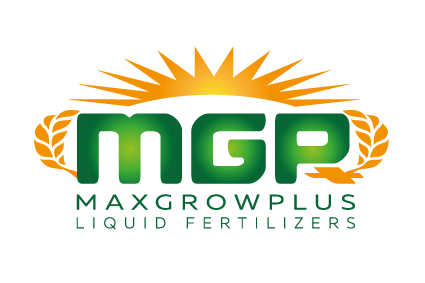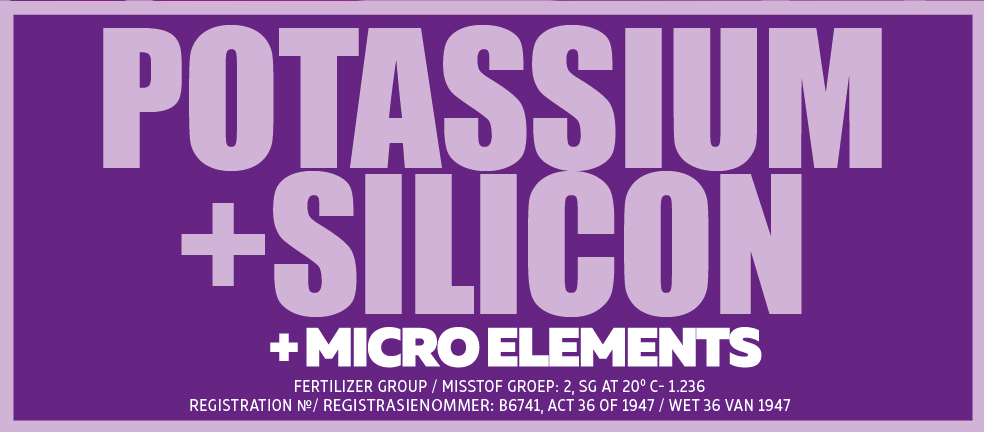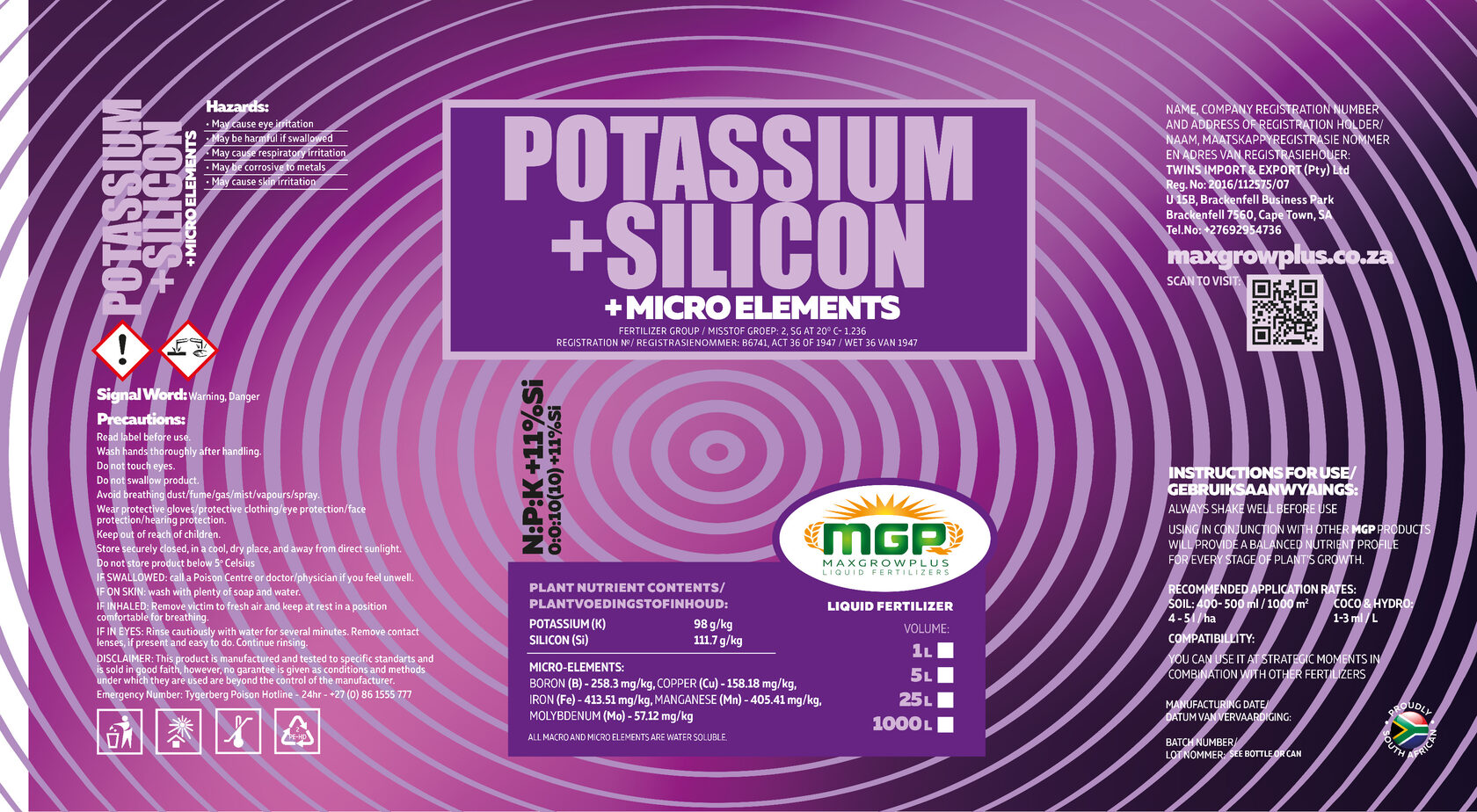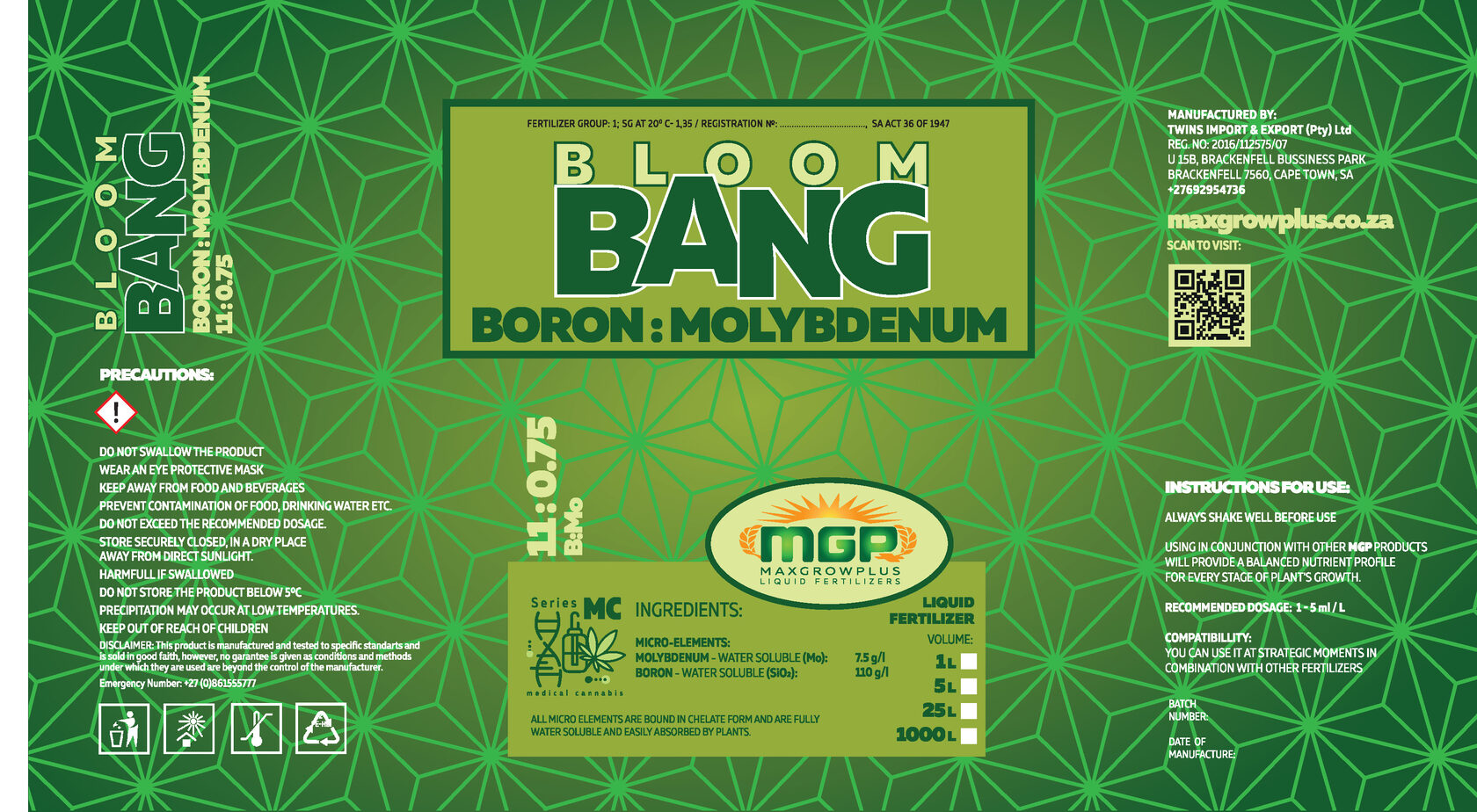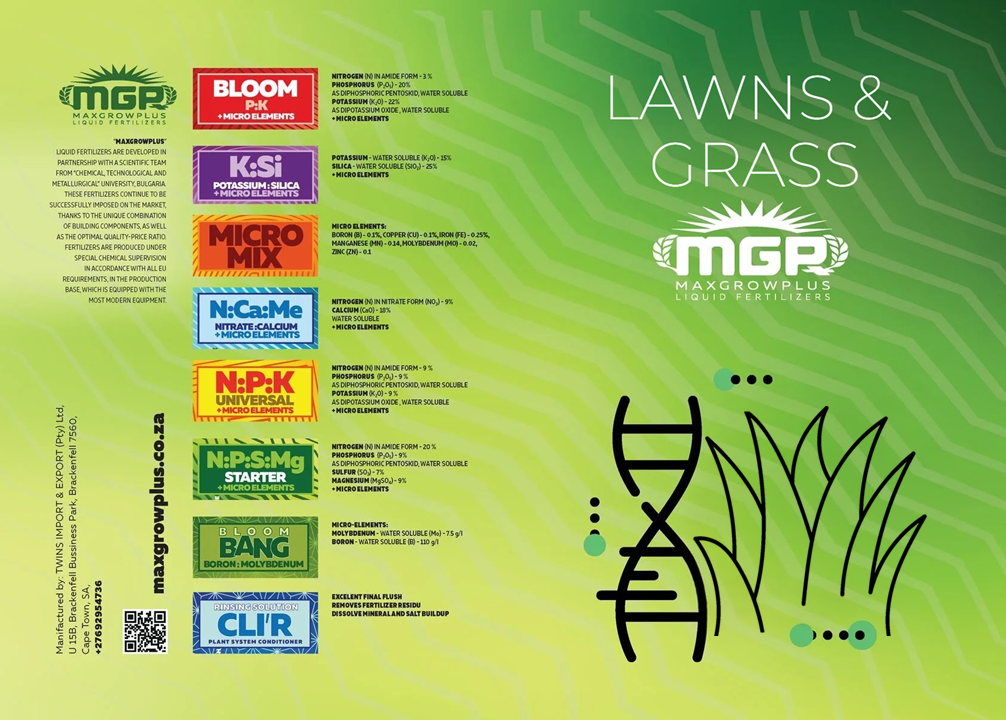MaxGrowPlus liquid fertilizers are designed for a wide range of crops, including wheat, corn, fruit trees, vegetables, citrus, flowers, and even specialized non-traditional crops. By expanding awareness and adoption of liquid fertilizers, MaxGrowPlus is committed to enhancing agricultural efficiency and sustainability in South Africa.
- Fast Absorption – Easily taken up by leaves and soil, ensuring efficient nutrient delivery.
- Precise Nutrient Control – Allows accurate feeding, reducing deficiencies and toxicity.
- Cost-Effective & High-Yield – Increase production while lowering feeding costs.
- Environmental Protection – Helps crops withstand stress from cold, salt, drought, etc.
- Versatile Application – Can be applied via foliar spraying or irrigation.
- Fast Absorption – Easily taken up by leaves and soil, ensuring efficient nutrient delivery.
- Precise Nutrient Control – Allows accurate feeding, reducing deficiencies and toxicity.
- Cost-Effective & High-Yield – Increase production while lowering feeding costs.
- Environmental Protection – Helps crops withstand stress from cold, salt, drought, etc.
- Versatile Application – Can be applied via foliar spraying or irrigation.

We continue the development of the company and our products with the implementation of new technologies in production.

MaxGrowPlus Starter + Micro Elements with a 20:4:0 ratio is a liquid fertilizer with a high content of nitrogen, sulfur, phosphorus, magnesium, and chelated micronutrients, suitable for foliar application and drip irrigation. Plants have the greatest need for nitrogen during the formation of reproductive organs, during periods of intensive vegetative growth, and especially during the development of leaf mass.
This liquid product is easy and safe to use, with a “gentle” effect on the leaves. It meets the specific nutritional needs of plants for nitrogen, sulfur, magnesium, phosphorus, and micronutrients.
Sulfur stimulates nitrogen uptake and thus has a positive impact on yield.
Magnesium is an essential plant nutrient. One of its main roles is in the process of photosynthesis, as it is a key component of chlorophyll.
Phosphorus plays a crucial role not only in plant development but also in the quantity and quality of the harvest: it accelerates the deep growth of root systems in young plants, shortens the juvenile period in fruit-bearing plants, promotes earlier flowering and fruit ripening, and improves plant resistance to diseases and cold.
The complex of macro- and micronutrients creates an optimal nutritional environment for both the initial growth and continued development of plants.
CONTENTS:
Nitrogen (N) 196.9 g/kg
Phosphorus (P) 38.5 g/kg
Sulfur (S) 31.1 g/kg
Magnesium (Mg) 31.3 g/kg
MICROELEMENTS:
Boron (B) 300 mg/kg, Iron (Fe) 220 mg/kg, Manganese (Mn) 130 mg/kg,
Copper (Cu) 60 mg/kg, Molybdenum (Mo) 30 mg/kg
Density 1.48 kg/L
pH 6.5 +/- 0.5
GENERAL APPLICATION INSTRUCTIONS:
Foliar feeding: use 0.4-0.5 liters of MaxGrowPlus Starter + Micro Elements per
1000 sq./m., dissolved in sufficient water for a complete spraying of the plants. Repeat treatments may be helpful.
Fertigation (Irrigation): multiple applications at 2-3 liters applied with the irrigation water by drip irrigation or micro-sprinkling.
ALL MICRO ELEMENTS ARE BOUND IN CHELATE FORM AND ARE FULLY WATER SOLUBLE AND EASILY ABSORBED BY PLANTS.
MaxGrowPlus Universal + Micro Elements is an NPK fertilizer with a nitrogen, phosphorus, and potassium formulation in a 9:4:7 ratio, enriched with a variety of micronutrients. The predominant nitrogen content in the MaxGrowPlus Universal + Micro Elements liquid fertilizer makes it an essential nutrient throughout the entire growth period of plants. When applied in the appropriate dose and manner, it also serves as a fertilizer to help plants cope with stress caused by climatic conditions, treatments with plant protection products, pests, and other factors.
CONTENTS:
Nitrogen (N) 89.8 g/kg
Phosphorus (P) 38.5g/kg
Potassium (K) 71g/kg
MICROELEMENTS:
Boron (B) 210 mg/kg, Iron (Fe) 230 mg/kg, Manganese (Mn) 130 mg/kg,
Copper (Cu) 110 mg/kg, Molybdenum (Mo) 30 mg/kg
Density 1.26 kg/L
pH 7.4 +/- 0.5
GENERAL APPLICATION INSTRUCTIONS:
Foliar feeding: use 0.4-0.5 liters of MaxGrowPlus Universal + Micro Elements per
1000 sq./m., dissolved in sufficient water for a complete spraying of the plants. Repeat treatments may be helpful.
Fertigation (Irrigation): multiple applications at 2-3 liters applied with the irrigation water by drip irrigation or micro-sprinkling.
ALL MICRO ELEMENTS ARE BOUND IN CHELATE FORM AND ARE FULLY WATER SOLUBLE AND EASILY ABSORBED BY PLANTS.
CONTENTS:
Nitrogen (N) 25.5 g/kg,
Phosphorus (P) 84 g/kg,
Potassium (K) 182.1 g/kg,
Diphosphoric pentoxide (P 2 O 5 ) 19%
Dipotassium oxide (K 2 O) 22%
MICRO ELEMENTS:
Boron (B) 200 mg/kg, Iron (Fe) 240 mg/kg, Manganese (Mn) 130 mg/kg,
Copper (Cu) 60 mg/kg, Molybdenum (Mo) 30 mg/kg
Density 1.49 kg/L
pH 7.9 + 0.5
GENERAL APPLICATION INSTRUCTIONS:
MaxGrowPlus Bloom + Micro Elements liquid fertilizer can be used alone or mixed with other liquid fertilizers and pesticides.
Foliar feeding: use 0.4-0.5 liters of MaxGrowPlus Bloom + Micro Elements per
1000 sq./m., dissolved in sufficient water for a complete spraying of the plants. Repeat treatments may be helpful.
Fertigation (Irrigation): multiple applications at 2-3 liters applied with the irrigation water by drip irrigation or micro-sprinkling.
ALL MICRO ELEMENTS ARE BOUND IN CHELATE FORM AND ARE FULLY WATER SOLUBLE AND EASILY ABSORBED BY PLANTS.
elements. It is an excellent product for rapid response by foliar application when more than one trace element is deficient. Micronutrients show 10-20 times higher efficiency when applied through the leaves than when applied to the soil. MaxGrowPlus MicroMix liquid fertilizer is also used to treat the seeds before planting for better germination and resistance in adverse conditions.
MICRO ELEMENTS:
Iron (Fe) 2700 mg/kg, Manganese (Mn) 1400mg/kg, Copper (Cu) 1070 mg/kg,
Zinc (Zn) 1100 mg/kg, in rapidly digestible chelated form: Boron (B) 900 mg/kg, and
Molybdenum (Mo) 200 mg/kg.
Density 1,1 kg/L
pH 4.6 +- 0.5
GENERAL APPLICATION INSTRUCTIONS:
MaxGrowPlus MicroMix liquid fertilizer can be applied alone or mixed with other liquid fertilizers and pesticides.
Foliar feeding: Use 0.4-0.5 litres of MaxGrowPlus MicroMix liquid fertilizer per 1000 sq./m., dissolved in enough water to spray the plants thoroughly. Repeat treatments may be helpful.
Fertigation (Irrigation): multiple applications at a dose of 2-5 litres of MaxGrowPlus MicroMix liquid fertilizer per hectare, applied with half the water through drip irrigation or micro-raining.
Seed treatment: When treating seeds, apply 1-2 litres of MaxGrowPlus MicroMix liquid fertilizer per 1(one) ton of seed.
ALL MICRO ELEMENTS ARE BOUND IN CHELATE FORM AND ARE FULLY WATER SOLUBLE AND EASILY ABSORBED BY PLANTS.
Feeding with MaxGrowPlus Nitrogen + Calcium + Micro Elements provides plants with two absolutely essential nutrients—nitrogen and calcium—which aid in the synthesis of elements within the fruit. It enhances fruit formation, improves quality, and extends the shelf life of the produce.
Calcium is poorly available in acidic, sandy, or light soils (leached soils), acidic peat soils, and during drought conditions. A calcium deficiency often occurs in fruits with high nitrogen or potassium content or in large fruits.
Calcium deficiency manifests as leaf tip burn, curled leaves, damaged growing points, reduced fruit firmness, spotting, and poor storability.
CONTENTS:
Nitrogen (N) 90.8 g/kg
Calcium (Ca) 125.9 g/kg
MICROELEMENTS:
Boron (B) 300 mg/kg, Iron (Fe) 200 mg/kg, Manganese (Mn) 200 mg/kg,
Copper (Cu) 110 mg/kg, Molybdenum (Mo) 30 mg/kg
Density 1.40 kg/L
pH 4.6 +/- 0.5
GENERAL APPLICATION INSTRUCTIONS:
Foliar feeding: use 0.4-0.5 liters of MaxGrowPlus Nitrogen + Calcium + Micro Elements per 1000 sq./m., dissolved in sufficient water for a complete spraying of the plants. Repeat treatments may be helpful.
Fertigation (Irrigation): multiple applications at 2-3 liters applied with the irrigation water by drip irrigation or micro-sprinkling.
ALL MICRO ELEMENTS ARE BOUND IN CHELATE FORM AND ARE FULLY WATER SOLUBLE AND EASILY ABSORBED BY PLANTS.
with a predominant content of silicon and potassium with ratio 0:0:10. It is intended for a wide range of cultures in the initial stages of their development, as well as for those in a period of highest metabolic activity. MaxGrowPlus Potassium + Silicon + Micro Elements liquid fertilizer strengthens the resistance of plants in conditions of unfavourable abiotic environment, stimulates the process of photosynthesis, the synthesis of endogenous phytohormones (gibberellins, cytokinins), the activity of respiratory enzymes (peroxidase), etc. Plants absorb silicon in amounts equivalent to or higher than those of the major macronutrients nitrogen, phosphorus and potassium (N,P,K). Having penetrated the plant organism, silicon is deposited between the cuticle and the cell wall, as well as between the cell wall and the cell membrane. Amorphous silicon layers act as a physical barrier against drought stress (optimizes the transpiration process), salinity stress (inhibits Na uptake), attack by insect enemies, fungal and bacterial pathogens. MaxGrowPlus Potassium + Silicon + Micro Elements liquid fertilizer provides control over the mobility of heavy metals in the soil-plant system, reducing their accumulation in the reproductive organs. It activates the protective reactions of plants, increases their strength, reduces the use of pesticides, which ensures a high yield and quality of production.
GENERAL APPLICATION INSTRUCTIONS
Foliar 5L per Ha:
- Vegetables: after transplanting or sprouting twice in 10-14 days;
- Potatoes: twice before flowering and during tuber thickening;
- Fruits and berries: twice after flowering and during the period of knot formation;
- Cereal crops: beginning of twining;
- Maize: phase 6-8th leaf;
DO NOT USE DURING FLOWERING!!!
CONTENTS:
Potassium (K) 98 g/kg
Silicone (Si) 111.7 g/kg
dipotassium oxide (K 2 O) 10%
Silicon dioxide (SiO 2 ) 24%
Micro elements:
Boron (B) 258.3 mg/kg, Copper (Cu) 158.18 mg/kg, Iron (Fe) 413.51 mg/kg,
Manganese (Mn) 405.41 mg/kg, Molybdenum (Mo) 57.12 mg/kg
MIXABILITY:
MaxGrowPlus Potassium + Silicon + Micro Elements liquid fertilizer can be
mixed with plant protection preparations after a miscibility test in small quantities. DO NOT MIX with products having high acidity (pH-6)
ALL MICRO ELEMENTS ARE BOUND IN CHELATE FORM AND ARE FULLY WATER SOLUBLE AND EASILY ABSORBED BY PLANTS.
associated plant diseases.
Aqueous nano solution, used to treat plants, is reported to exhibit excellent preventive effects on pathogenic microorganisms. Moreover, it promotes the physiological activity and growth of plants and induces disease and stress resistance in plants. It has long been known to have strong pesticidal, antifungal, anti-viral, and bactericidal effects.
Due to plant disease, agricultural production is reduced worldwide every year; therefore, a vast amount of funding has been invested in efforts to control plant diseases. Various natural and artificial methods of control for protection of plants from these diseases have been applied.
Among methods for disease control, the use of pesticides is the most prevalent.
In recent years, environmental hazards caused by excessive use of pesticides have been widely discussed; therefore, researchers in the agricultural field are searching for alternative measures against pesticides. Nanotechnological applicability in crop disease protection offers a great promise in the management of insects and pathogens. Specific nano-particles are very effective against phyto-pathogens with low toxicity and lead to a broad range of applicability in pesticidal activity. It is efficiently used for site-targeted delivery of important agrochemical products and for diagnosis purpose tools in case of prior detection of plant diseases.
ALL MICRO ELEMENTS ARE BOUND IN CHELATE FORM AND ARE FULLY WATER SOLUBLE AND EASILY ABSORBED BY PLANTS.
*coming soon
*coming soon
*coming soon
We develop a scheme for the application of our product to cannabis.
RYE
SINGLE fertilization: between the first stem branch and the first ear of wheat:
MAXGROWPLUS STARTER NPS Mg + ME + Mn+Zn + Cu (5,0 L per HA)
DOUBLE fertilization: between the first branch of the stem and the first ear of wheat:
1) MAXGROWPLUS STARTER NPS Mg + ME + Mn+Zn + Cu (5,0 L per HA),
2) MAXGROW PLUS UNIVERSAL NPK + ME +Mn + Zn + Cu (5,0 L per HA) - after 14 days
Foliar fertilization of cereal crops is highly necessary during the various phases of their development:
Nitrogen is the most important nutrient for achieving high yield and quality.
Phosphorus, the need for phosphorus is greater at the beginning of development and during flowering. Phosphorus enhances root growth, accelerates general development, and stimulates grain formation. It is necessary for the assimilation of nitrogen. With appropriate fertilization, the yield can be increased by 30-40%. In case of deficiency, the development slows down, the plants are small, the cobs are deformed, and the moisture in the grains is released more slowly. In large excess, it blocks zinc in the soil.
Potassium participates in many enzyme systems that regulate growth, is important for protecting plants from disease, for water balance, improves resistance to low temperatures, vital for photosynthesis. In case of deficiency, the nitrogen metabolism is disturbed, toxins accumulate in the tissues, necrosis occurs, the plants dry up, and they lay down more.
Sulphur stimulates growth, normal functioning of leaves, synthesis of various substances,
and facilitates nitrogen absorption. In case of sulphur deficiency, the plants are small, with elongated pale green and yellow leaves, interveinal chlorosis appears, and the quality and reproduction of the seeds deteriorate greatly.
Calcium's application is imperative in acidic soils, develops the root system, stabilizes cell walls, plants are healthier, resistant to low and high temperatures, and diseases. With a lack of calcium, the plants remain small, the young leaves are curled, sticky, and necrotic spots appear.
Magnesium - an important part of photosynthesis - transforms solar energy, a building block of chlorophyll. It is necessary for cell division and protein formation, for phosphate metabolism, and for the activation of many enzymes. In case of deficiency, yellow spotted chlorosis develops, the efficiency of phosphorus fertilization decreases, and the yield falls.
Copper participates in the construction of many enzymes, the formation and growth of grain, in the composition of chlorophyll and is important for photosynthesis. Many diseases disappear with good fertilization with honey. A lack of copper slows down or reduces the formation of starch, the leaves curl, the tips turn white, the ears are empty, the grains shrivel, and the plants die.
Boron is important for pollen germination and pollination, calcium absorption, cell construction and function, seed setting and yield.
Molybdenum with very important participation in nitrogen metabolism, in the conversion of nitrates into amino acids and inorganic phosphorus into organic, to reduce the levels of unprocessed nitrates and nitrites, to protect against certain diseases and enemies, to pollinate flowers. In case of deficiency, the young leaves are pale, the spikes fade, the grains are shrivelled, and ripening is delayed.
Zinc - it is necessary for the normal growth and reproduction of plants, for carbohydrate
metabolism, protein metabolism, pollen formation, resistance to infection by pathogens and enemies. In case of deficiency, plants become bronze, leaves become yellowish with rusty spots and begin to break and die.
Manganese - participates in many physiological processes, in the synthesis of lignin, in the formation of the wax coating on the leaves, stems and spikes. A deficiency of manganese deteriorates the quality, the dry matter drops, and the yield decreases. Susceptibility to disease, enemies, drought, and heat stress increases.
When watering, easily soluble nutrients are washed from the surface soil layer. The root system of the grass vegetation in the green areas develops up to 40-50 cm, as it is continuously maintained in the budding phase through mowing. With more frequent and low mowing, the roots develop more shallowly. With a lack of nutrients, weed vegetation takes precedence, and the longevity of the grass stands decreases. In other words, lawn fertilization should not be neglected. For intensively maintained gardens and yards, it is recommended to fertilize with combined fertilizers once or twice a month at a rate of 4g/sq.m. When fertilizing, it is important to spread the fertilizers evenly and to water them abundantly after fertilizing to dissolve them. Fertilization usually starts in March with combined fertilizers. During the growing season, it can also be fertilized with nitrogen, and in October again with combined fertilizers, preferably with a higher phosphorus content.
The main elements needed by the grass are nitrogen, phosphorus, potassium, magnesium, and from the trace elements boron, copper, iron, manganese, molybdenum, and zinc.
Nitrogen, as a component of the chlorophyll molecule, plays an important role in the process of photosynthesis, in the formation of leaf mass. The grass needs about 20-30 kg/ha of nitrogen fertilizer per year. Spread this dose over the season.
In the case of an insufficient supply of plants with nitrogen, disturbances occur in the formation of chlorophyll and the growth of the plant's organism. Depending on the degree of nitrogen deficiency, the intensity of colouring of the leaves also changes, from pale green to yellow-green and even yellow. Initially, the veins and adjacent tissues fade or turn yellow, while the remaining parts retain their light green colour. Later, the leaves turn orange or brown and die. These signs appear first in the older leaves and then in the younger ones, which is related to the withdrawal of nitrogen from the older leaves to support the growth of the younger ones. The lack of nitrogen stops the process of cell division in the growth points or in the germinal tissues, which is why a decrease in the leaf surface area is caused, and growth is stopped.
In case of excessive and one-sided nitrogen fertilization, the growth is over-enhanced, the
vegetation period is extended, the accumulation of nitrogenous organic substances, especially of proteins, increases, the leaves grow wildly and acquire a dark green colour. Due to the accumulation of more proteins, which are highly hydrophilic, plant tissues are soft and juicy, as a result of which they are attacked to a greater extent by fungal pathogens and insects, and the plants themselves show a greater tendency to lay down.
In the initial phase of their development, plants use a relatively small amount of the
absorbed nitrogen, but it is necessary to avoid stunting of leaf growth. Lack of
readily available nitrogen immediately after seed germination also adversely affects root
development, thereby limiting the uptake of other nutrients. Plants have the greatest need for nitrogen when the vegetative organs are growing intensively. In other words, the lack of
nitrogen at the beginning of the growing season and during the active growth of the leaf
mass, and the corresponding excess at the end of the growing season, adversely affect the grass.
The presence of the microelements Mo, Fe, Cu, V, Mn and the macro element phosphorus influences the more efficient assimilation of nitrogen in the plants themselves.
Phosphorus stimulates the growth of the root system in depth, which increases the drought resistance of plants, stimulates twining, accelerates development, reduces the hydrophilicity of leaves, thereby contributing to increasing resistance to diseases and enemies. With a lack of phosphorus, the colour of the leaves changes to dark green. As the shortage deepens, a strip of red-violet colour appears on the periphery of the leaves, which extends from the tip to the base of the petiole. Gradually, these stripes cover the entire leaf, which turns, and the affected tissues die. The plants acquire a bronze and purple hue, due to the relatively increased content of sugars that stimulate the formation of anthocyanins.
The excess of phosphorus leads to the formation of hard-to-dissolve compounds with the trace elements metals - Fe, Mn, Cu, Zn and the appearance of induced chlorosis due to the lack of these trace elements.
Phosphorus is absorbed unevenly during the growing season. It has been established that in the initial phases of their development, plants absorb phosphorus more intensively, which they distribute and use later as building material. The highest rate of phosphorus uptake occurs during the period of maximum growth.
Potassium fertilization stimulates the growth of grasses, their resistance to diseases and cold resistance.
With a lack of potassium, the growth of the roots is stopped in length, the lateral roots appear only at the base of the main root. The leaves, initially on the old ones, lose their lustre, acquire a dull green colour, and chlorotic areas are formed on them, especially between the veins. Later, larger or smaller brown spots appear on the leaves, concentrated mainly on their periphery, as they gradually grow, the leaves wither. In wheat grasses, potassium is absorbed most intensively during germination. Effective absorption of this macro element is influenced by Ca2+, Mg2+ 2+ and NH4+, which are its antagonists.
Need for fertilization with trace elements.
Magnesium participates in the chlorophyll molecule and is an activator of many enzymes in a number of synthetic and metabolic processes. Its deficiency leads to a strong decrease in the chlorophyll content in the leaves. Chlorosis is observed on older leaves. Chlorotic spots are located between the veins of the leaves; later, the tissues become necrotic.
Iron participates in photosynthesis, respiration, biosynthesis of proteins and chlorophyll,
and assimilation of nitrogen. In case of deficiency of this trace element, chlorosis is observed. Initially, between the veins, the leaves acquire a pale green and then a light-yellow colour. The veins remain pale green with a reddish tint. Plants use Fe in small amounts throughout their growing season. As the leaves grow, the need for them increases. Micronutrients are best absorbed by plants in chelated form.
Application recommendation:
Sheet application
1. MAXGROWPLUS STARTER NPS Mg + ME at a consumption rate of 0.5 litres/1000 sq.m (when spraying with a backpack sprayer, 200 ml of liquid fertilizer is dissolved in 10 litres of water). A balanced ratio of the main nutritional elements and provision of the necessary trace elements.
Foliar application
2. MAXGROWPLUS UNIVERSAL NPK + ME at a consumption rate of 0.5 litres/1000 sq.m (when spraying with a backpack sprayer, 200 ml of liquid fertilizer is dissolved in
10 litres of water).
BLACKBERRIES
MAXGROWPLUS liquid fertilizers are suitable for foliar application and fertigation. They
contain the main macronutrients in the right ratio for intensive growth and development of your citrus trees. It is also enriched with a micronutrient package that provides optimal nutrition for plants from the citrus group. Micronutrients are also added to improve common nutrient deficiencies in citrus trees.
MAXGROWPLUS liquid fertilizers support the intensive development of leaf mass, stimulate the development of the root system, improve the resistance of trees to heat and drought. The treated trees show an increase in yield, a reduction in fruit falling and splitting, an increase in sweetness, and an increase in shelf life.
Citrus crops respond very well to feeding with complex liquid fertilizers. With a lack of nitrogen, phosphorus, and potassium, their growth is suppressed, and the leaves turn yellow. They need more zinc and are sensitive to magnesium and manganese deficiency.
Citrus trees need a lot of nitrogen and also large amounts of calcium and potassium. They stimulate the flowering and fruiting of the tree, Ca is necessary for the development of the root system and for strengthening the cell walls, which also leads to healthier fruits that do not crack and have a longer shelf life.
Recommendations for foliar feeding of citrus fruits:
1. Before flowering
MAXGROWPLUS STARTER NPS Mg + ME + Mn, Zn, B
At a cost rate:
Foliage: 0.5 – 1 liter /1000m²
When spraying with a backpack sprayer, prepare a working solution containing 200 ml of liquid fertilizer dissolved in 10 liters of water.
Fertigation 3 – 5 liters/1000m²
2. Beginning of flowering
MAXGROWPLUS UNIVERSAL NPK + ME
At a cost rate:
Foliage: 0.5 – 1 liter /1000m²
When spraying with a backpack sprayer, prepare a working solution containing 200 ml of liquid fertilizer dissolved in 10 liters of water.
Fertigation 3 – 5 liters/1000m²
3. After fruit formation (by alternating every 10-15 days)
MAXGROWPLUS BLOOM PK + ME
At a cost rate:
Leafy: 0.5 – 1 liter /1000m²
When spraying with a backpack sprayer, prepare a working solution containing 200 ml of liquid fertilizer dissolved in 10 liters of water.
Fertigation 3 – 5 liters /1000m²
MAXGROWPLUS NCa + ME
At a cost rate:
Foliage: 0.5 – 1 liter /1000m².
When spraying with a backpack sprayer, prepare a working solution containing 200 ml of liquid fertilizer dissolved in 10 liters of water.
Fertigation 3 – 5 liters/1000m²
roots, stems, leaves, flowers, and in the following phases, a deficiency may occur, leading to a decrease in yield and the quality of the final product. Therefore, foliar fertilisation is preferred.
Scheme for feeding leafy vegetables with MAXGROWPLUS liquid fertilizers:
For seedlings, 10-15 days after the first treatment, MAXGROWPLUS STARTER NPS Mg + ME - (2.5L/Ha)
This way of feeding can be alternated every 10-15 days.
30 days after transplanting MAXGROWPLUS STARTER NPS Mg + ME (5L/Ha )
30-40 days after transplanting, they can alternate.
MAXGROWPLUS UNIVERSAL NPK + Micro Elements (5L/Ha)
MAXGROWPLUS BLOOM + Micro Elements (5L/Ha)
Green Leafy Vegetables Include:
Lettuce, Spinach, Coriander, Mint, Curry Leaves, Fenugreek, Cabbage, Beet greens, Turnip greens, Mustard greens, Kale, Fennel greens, Watercress, Celery, Parsley, Artichoke, Spring onion, Dill leaves, Broccoli, Arugula, Asparagus, Perilla, Leek, Swiss chard, Collard greens, Romanie, Iceberg, Chinese cabbage, Purslane, Endive, Rapini, Roselle leaves, Amaranth leaves, Chives, Sweet Basil, Water spinach, Grass pea leaves, Radicchio, Stinging nettle, Drumstick greens, Mache, Fiddlehead greens, Saluyot leaves, Sorrel, Garden cress
ORNAMENTAL PLANTS
Intense growth
Regular feeding of trees and decorative plants with MAXGROWPLUS liquid fertilizers
contributes to improving their appearance, stimulates growth and leaf formation.
table. Green ornamental shrubs need more magnesium and nitrogen to stay fresh,
green and grow healthy. Nitrogen is a major component of chlorophyll and stimulates growth, magnesium is key to chlorophyll. The balanced ratio of macro- and
trace elements in MAXGROWPLUS liquid fertilizers accelerates the process of photosynthesis and provides intensive plant growth and optimal foliage.
The iron contained in MAXGROWPLUS liquid fertilizers guarantees wonderful green leaves.
Advantages of foliar feeding of trees, evergreen, and ornamental plants with MAXGROWPLUS liquid fertilizers:
Contains all the necessary essential nutrients and trace elements
Faster and uniform plant growth
Ensures proper nutrition for all green leafy ornamental plants
Increases resistance to drought stress, temperature changes, etc.
Application recommendation:
Sheet application:
1. MAXGROWPLUS STARTER NPS Mg + ME at a consumption rate of 0.5 litres/1000m² (when spraying with a backpack sprayer, 200 ml of liquid fertilizer is dissolved in 10 litres of water).
Foliar application:
2. MAXGROWPLUS UNIVERSAL NPK + ME at a consumption rate of 0.5 litres/1000m² (when spraying with a backpack sprayer, 200 ml of liquid fertilizer is dissolved in 10 litres of water).
Feeding should be done every 10-14 days, alternating between the two types of liquid fertilizer.
full development. They need a certain amount of macro and microelements for their normal development.
The presence of nutrients in the soil does not always guarantee complete nutrition. Various factors (including soil pH, excess moisture, drought, disease, pests, weeds) affect nutrient availability and assimilative capacity of the plant root system. For example, potassium and the nitrate form of nitrogen are easily washed out of the soil, and phosphorus chemically combines with calcium, magnesium, and iron, forming hard-to-dissolve mineral compounds unavailable to plants. The way out of such a situation is foliar feeding with a balanced complex liquid fertilizer, which leads to rapid absorption of the necessary nutrients, rapid correction of the imbalance of mineral nutrition elements, and a 15-20% increase in the consumption of nutrients from the soil through the root system of plants.
Liquid complex fertilizers are widely used in agriculture. Foliar feeding of plants with
MAXGROWPLUS liquid fertilizers lead to: uniform distribution and complete absorption of nutrients, much faster development of the leaf mass, strengthening of the stem, and development of a stable root system. Foliar nutrition allows for feeding plants that have just been planted and whose root system is not yet well developed, and also for emergency intervention on plants stressed by adverse climatic conditions. The MAXGROWPLUS complex liquid fertilizers developed by us are completely balanced in terms of the macro and microelements they contain. They are created with different proportions of nutritional elements according to the specific requirements of crops, depending on the phases of their development. The macro (N, P, K, Mg, Ca) and micro elements (Mo, Zn, Fe, Cu, Mn, B) contained in them are completely water-soluble and are in a form that is as easily absorbed by plants as possible. The trace elements included in their composition are in chelated form for maximum availability. With MAXGROWPLUS liquid fertilizers developed in this way, several tests were conducted in agricultural institutes, and an increase in yields and an improvement in the quality of the production were recorded for the treated crops.
Through the use of MAXGROWPLUS liquid fertilizers in the cultivation of decorative
plants, a balanced nutrition with macro and microelements will be achieved and, in this way, various of their qualities will be improved - very well-developed leaf mass, intensive spreading, enhanced flowering, improvement of the development of the root system, increase of stress resistance.
Frost means stress for plants. In order to improve frost resistance, a sufficient supply of the nutrients potassium and boron must be ensured for the plants. Boron stimulates the absorption of potassium.
Despite the often high contents of iron oxide in the substrates, iron chlorosis is widespread in the cultivation of ornamental plants. If symptoms are present, it can be overcome by foliar application of MAXGROWPLUS liquid fertilizers.
Fertilization needs to be carried out throughout the growing season, because the main and seed fertilization cannot fully satisfy the plant's needs for nutrients to develop optimally.
In the decorative vegetation used in the field of landscape design and greening, the selected forms need regular feeding, and also, when growing on sandier soils, when watering, the nutrients are easily washed away and removed from the soil.
Foliar feeding of plants can begin at the beginning of their vegetative growth. During this period, they need nitrogen, magnesium, and sulfur (MAXGROWPLUS STARTER NPS Mg + ME); the growth of the plant is stimulated, the stem is strengthened, and significant leaf mass develops.
Phosphorus stimulates the development of the root system.
In the period when the buds are formed, it is important to feed the ornamental plants with nitrogen, phosphorus, potassium, and boron (MAXGROWPLUS UNIVERSAL NPK + ME).
In the second half of summer, perennial plants mainly need phosphorus and potassium, which increase the cold resistance of plants. The last feeding is done no later than the middle of August, then usually the ornamental trees and shrubs begin to accumulate nutrients with which to survive the winter and bloom again in the spring.
Application recommendation:
In the initial phases to stimulate rooting and for intensive growth
Sheet application:
1. MAXGROWPLUS STARTER NPS Mg + ME at a consumption rate of 0.5 litres/acre (when spraying with a backpack sprayer, 200 ml of liquid fertilizer is dissolved in 10 litres of water)
A balanced ratio of the main nutritional elements and provision of the necessary trace elements
Foliar application:
2. MAXGROWPLUS UNIVERSAL NPK + ME at a consumption rate of 0.5 litres/1000 sq/m(when spraying with a backpack sprayer, 200 ml of liquid fertilizer is dissolved in 10 litres of water).
For flowering plants, to stimulate flowering, it is recommended
Foliar application:
3. MAXGROWPLUS UNIVERSAL NPK + ME + B at a consumption rate of 0.5 litres/1000 sq/m (when spraying with a backpack sprayer, 200 ml of liquid fertilizer is dissolved in 10 litres of water).
2-3 applications of MAXGROWPLUS UNIVERSAL NPK + ME are recommended during the growing season.
For perennial plants, around August 15 (to increase the cold resistance of plants)
Preparation for winter – MAXGROWPLUS BLOOM PK + ME at a rate of consumption - 0.5 litres/1000 sq/м (when spraying with a backpack sprayer, 200 ml of liquid fertilizer is dissolved in 10 litres of water).
Nitrogen – influences growth, the synthesis of amino acids, proteins, chlorophyll, etc., and increases yield. In nitrogen deficiency, plants lag in growth, older leaves turn yellow, small flower heads form, and the number of seeds is low. Excess nitrogen causes vigorous vegetative growth, reduces oil content, and lowers resistance to most diseases.
Phosphorus – supports germination, root system development, accelerates flowering and seed ripening, increases oil content and yield, and enhances the plant's resistance to drought and frost. In phosphorus deficiency, the root system is poorly developed, leaf edges discolor, and older leaves dry out prematurely.
Potassium – is important for the synthesis and transport of proteins and carbohydrates, contributes to productive growth, yield, seed filling, and oil content, and increases resistance to lodging, frost, and drought. Potassium deficiency slows growth and root formation, causes chlorosis along leaf edges, and leads to plant wilting.
Sulfur – stimulates overall growth, the synthesis of oils and proteins, facilitates nitrogen uptake by the sunflower, and increases yield and product quality. In sulfur deficiency, young leaves first, and then the entire plant, become light green, and sunflower growth slows down. Seeds are few, light, and of very low quality.
Calcium – supports strong root system development, stabilizes cell walls and membranes, and ensures healthy tissues. Calcium deficiency results in shorter plants, wrinkled young leaves, and necrotic spots.
Magnesium – accelerates growth, increases yield and oil quality in seeds. It plays a crucial role in photosynthesis, respiration, and the uptake and transport of phosphorus. Magnesium deficiency causes interveinal chlorosis and slows down overall growth.
Boron – plays an important role in the development of young tissues, pollen formation, embryo development, and proper seed formation. It helps form healthy, well-attached, and fully developed sunflower heads. Boron deficiency deforms leaves and causes necrotic spots. Flowers and heads become misshapen, some seeds are empty, hollow stems may appear, and the plant may bend.
Molybdenum – supports effective nitrate assimilation and pollination, helps in the uptake and utilization of phosphorus and iron by plants. In molybdenum deficiency, nitrogen fertilization becomes ineffective, and chlorosis appears on older leaves. Molybdenum deficiency most commonly occurs in acidic soils.
Manganese, zinc, copper, and iron – participate in photosynthesis and metabolic processes, are components of enzymes and proteins, and assist in the absorption of other nutrients.
Recommendations for foliar feeding of sunflowers:
MAXGROWPLUS STARTER NPS Mg + ME + B + Mo apply from 4-6 to 6-8 double leaf stage.
Foliage: 0.5 – 1 liter /1000m²
When spraying with a backpack sprayer, prepare a working solution containing 200 ml of liquid fertilizer dissolved in 10 liters of water.
Fertigation 3 – 5 liters/1000m²
MAXGROWPLUS UNIVERSAL NPK + ME + B + Mo apple before flowering/bud formation.
Foliage: 0.5 – 1 liter /1000m²
When spraying with a backpack sprayer, prepare a working solution containing 200 ml of liquid fertilizer dissolved in 10 liters of water.
Fertigation 3 – 5 liters/1000m²
- It achieves a very fast effect, as plants absorb substances that land on their leaves more quickly.
- The method is economical, because when nutrients are applied to the soil around the root zone, they often reach the deeper soil layers and are not absorbed by the plants.
Supplementing cucumbers with MAXGROWPLUS liquid fertilizers is very important because they grow quickly, require a large amount of nutrients, and their root system is underdeveloped and shallow. Cucumbers use the most nutrients during the flowering and fruit formation stages. They develop best in nutrient-rich soils with high fertilizer levels. When cucumbers begin to flower, they need a full range of micronutrients and an additional amount of boron.
Plants have a greater need for nitrogen and potassium, and a smaller one for phosphorus. During the growth of lateral branches, the uptake of potassium and phosphorus increases. Later, due to the intense increase in aboveground biomass, the need for nitrogen also increases.
Nitrogen is very important for cucumber yield. It stimulates overall plant growth. It is crucial that the plants reach good overall development by the flowering stage; otherwise, they will have a low yield potential. In case of nitrogen deficiency, plant growth and new leaf formation slow down. Lower leaves turn yellow, stems become thin, hard, and fibrous, and the plant produces few and small fruits.
Cucumbers need potassium the most, especially during the period of mass fruiting. Potassium increases the cucumbers' resistance to low temperatures, salinity, drought, and diseases. Cucumbers are one of the few crops that require more potassium than nitrogen. Fertilizing cucumbers with potassium increases yield. Potassium enhances disease resistance and reduces damage caused by diseases, such as angular leaf spot, gray mold (Botrytis), and powdery mildew. In case of potassium deficiency, older leaves develop yellow chlorosis, usually starting from the edges and then spreading to the areas between the veins. Older leaves become dry and paper-like to the touch. When potassium is lacking, fruits become deformed and develop brown spots. The plant becomes stunted, with shortened internodes and small leaves.
Since potassium, magnesium, and calcium are in competitive relationships, increased potassium fertilization in cucumbers should be balanced with fertilizers containing magnesium and calcium.
Phosphorus stimulates early plant growth and is important for the development of roots and the reproductive organs of cucumbers—flowers and fruits. Cucumbers need phosphorus throughout their growth cycle, but the greatest demand is from emergence to the beginning of flowering.
Cucumbers require no less than 50 kg/ha of magnesium. Magnesium deficiency symptoms appear as yellowing at the leaf edges and yellow spots on the leaves. As a result, plants become more susceptible to various diseases. Magnesium deficiency usually appears during flowering but becomes especially severe during intensive fruiting.
Overdosing nitrogen and potassium can lead to phosphorus deficiency and reduced yield. Overdosing potassium can cause calcium and magnesium deficiencies, which also lower yields. Potassium deficiency may cause iron deficiency and result in chlorosis.
Recommendations for foliar feeding of sunflowers:
Apply MAXGROWPLUS STARTER NPS Mg + ME + B + Mo when 4–6 leaves have formed.
Foliage: 0.5 – 1 liter /1000m²
When spraying with a backpack sprayer, prepare a working solution containing 200 ml of liquid fertilizer dissolved in 10 liters of water.
Fertigation 3 – 5 liters/1000m²
MAXGROWPLUS UNIVERSAL NPK + ME + B + Mo apple every 15-days.
Foliage: 0.5 – 1 liter /1000m²
When spraying with a backpack sprayer, prepare a working solution containing 200 ml of liquid fertilizer dissolved in 10 liters of water.
Fertigation 3 – 5 liters/1000m²
+27829440432
Contacts
+27692954736
+27753277287
support@maxgrowplus.co.za
Address
Unit B 15,
Brackenfell Bussiness Park,
Brackenfell 7560, Cape Town, SA
